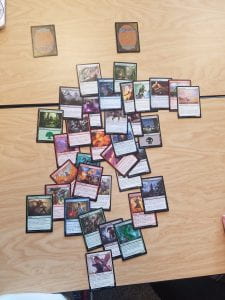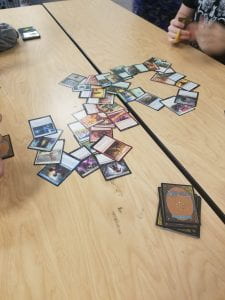Artist Statement
My game appropriates the art in Magic: The Gathering cards. I love the art of MTG cards, but during normal game play the art doesn’t serve a functional purpose. I took some influence from Richard Prince’s cowboy picture in which he cut the text out of the cigarette add to make a nice picture. I took inspiration from this in deciding that ignoring the text on the cards and only looking at the art was the goal of the game. I did not feel like it was worth cutting out the art as by leaving the art in the card frame makes the game playable by anyone with magic cards and means you can use any cards without worrying about ruining their monetary value. I also think the act of deliberately having to ignore the normally important text brings the contrast between my game and standard game play. This further highlights that his is not normal use for the cards.
The game is also made cooperative as the idea of taking a medium normally used for competitive play is a worthwhile contrast to make. Collages and tapestries are often collaborative works and represent a shared story. I took inspiration from Hausmann, Baader and Hoch and their photo montages in the Munich Dada scene. Though they didn’t make collaborative works, the montages are collections of pictures or words that make new pieces of art and appropriate other pieces of art. The end result of playing “Magical Canvas” is a montage of magic cards that tell a story. It takes many different artists and puts their work together into a new story.
I think my chosen appropriated material works well for my game and my purpose. Many people have some amount of Magic cards around their house, and this gives these old, often forgotten, cards a purpose. By giving the cards that most people toss aside as bulk commons and uncommons a new meaning, my game gives people something to play that uses all of their cards by re-framing how you use them. Both play tests of my game led to wild and unpredictable stories, and the ad-lib nature of the stories it makes lets them be free and honest expressions.
Play test overviews:
The first play test led to some on the spot rules changes from the original rules. The group came together and told a story of the bugle rock concert led by lead bugle player Johanes and his tree drummer Kimmothy. The cops showed up and shut it down with their sniper and the attendees scattered while the place burned down. One of the fans, Jeremy, joined the cops and fought a burning Kimothy until Johanes came to save the day. Johanes and Jeremy experiences a flash forward in a moment of hesitation in which they saw their future child and then rode off into the sunset to get married.

The second play test started with the burning of the flowers by the flower hating king. A dragon appeared and helped burn things but a brave fire-immune knight showed up and beat the dragon with a spear of flame. Her wife showed up to congratulate her and was immediately killed in the next card in a true “bury your gays” moment. I ended up losing track of the story as multiple plot thread then appeared and the group jumped from story to story within this world all branching from the original setting.

Final rules
Magical Canvas
Materials
- 1 deck of magic cards of at least 60 cards with no lands
- Each player may bring a small deck of 30+ cards for personal use, but there must be a shared deck for the table.
- 5 different land cards
Preparing the Deck
- Take bulk magic cards
- Pick at least 60 cards with art you like
- If you would like to have artistic consistency for your game, pick cards from the same set or block. Feel free to mix and match as you please.
- Put them into a deck without any lands
- Shuffle the deck
Preparing the Tapestry
- Shuffle the 5 land cards
- Place them face down on the table in any arrangement with no two cards touching
- As a group, decide on which card to flip face up. This is the starting location of the story
Gameplay
- Everyone draws 5 cards from either the shared deck or their own personal deck
- Starting with the player who has most recently taken a picture for social media, play progresses to the right
- When it is your turn and before you play a card from your hand, you may put on card onto the bottom of the deck and draw a new one
- Place 1 card from your hand onto the tapestry
- If the card is touching a face down card, flip it face up
- Using only the art on your card, describe what new part of the story the art represents. You must incorporate any cards that it is touching into the story.
- When you are done telling the next part of the story, draw a card and play passes to the next player.
Ending the Game:
The game is over when you finish the story. Take a picture of the canvas to remember the story and then shuffle all the cards back up returning them to their original owners.
Tips for Storytelling
- Follow the “yes and” rule. Don’t take your turn to subtract from the story. Use each turn to add new elements.
- The art represents some part of the story. Just because the actual character in the art may not be the same between two cards, you can take artistic liberty and decide that it IS the same character
~~~~
Iteration Process:
Originally I wanted to mimic how tabletop RPGs have a GM style character and wanted to create someone to act as the DM. However, when we got into storytelling it didn’t pan out well and the natural evolution of the story flowed better when everyone had the same power over the story. Additionally, rules to discard and draw once during your turn were added to help rotate cards out of your hand based on how the story was going. Instead of having to have a “dump” round, it became apparent that players should be able to discard a card. If I were to iterate on the discard mechanic again, I think I’d like to test revealing the card you wanted to discard and if someone could add it to the story on the spot in a clever way, they get to draw an additional card to increase their hand size. With this change I’d like to test 3 card hands with the ability to grow up to 5 or 6 cards. Overall, I think removing the “adversary” role made for a better experience and led to more fun and creative stories.
~~~~
Original draft
A game for 2-5 players
Materials:
- 1 Communal Deck of Magic: The Gathering (MTG) Cards
- 1 Adversary Deck (A smaller deck of MTG cards)
- 1 of Each Basic Land Type (Plains, Island, Swamp, Mountain and Forest)
- Each player may instead bring their own deck of cards to use in place of the community deck
Preparing the Communal Deck:
- Grab a bulk box of MTG cards
- Looking only at the art of the cards, pick a variety of characters, creatures and spells.
- For thematic consistency, pick cards from the same set/block. Picking cards from different sets/blocks can be used to create mash-up worlds and stories.
- The deck should be curated down to no more than 60 cards, and should not include land cards
Preparing the Adversary Deck:
- Grab a bulk box of MTG cards or an existing themed deck (Commander decks work well for this, especially ones that follow a theme)
- Looking only at the art of the cards, pick a group of creatures and spells to represent the trials in the story.
- The deck should be curated down to no more than 15 cards.
Preparing the Canvas:
- Pick 5 land cards to act as settings. Shuffle them together
- Place them face down in any shape you please
- As a group, pick one face down card to be the starting setting and flip it face up
Setup:
- The host of the game draws 3 cards from the adversary deck
- Each other player draws 5 from the communal deck (or from their own deck)
- Play starts with the host.
Gameplay:
- On your turn, play a card from your hand onto the canvas.
- The text on the card does not matter, only the card art needs to be taken into consideration.
- The card must be touching a currently face up card.
- If the card touches a face down card, turn that card face up.
- Expand on the current story by describing what happened when you played your card. The story must include the story events from all cards it currently touches.
- When you are done with your addition to the canvas, draw a card from the appropriate deck (communal if a player, adversary if a host).
- Story control passes to the right.
Ending the Game:
- The game is over when either the adversary deck is empty, or the story has reached a satisfying conclusion.
- Take a picture of the canvas you created as you told your story.
- Shuffle all the cards together and return them to their original owner.
Tips for Placing Cards:
- The character on the card does not matter if you are not using it to establish a character.For example, if you had a knight and then a card showing a different knight fighting a monster, you can tell the story as if they are the same character
- Use the position of the cards to help you tell the story. For example, if you could use a card depicting a sword to arm a knight, or you could turn it upside down and “stab” the knight with it.
- Follow the “Yes and” rule of improv. Always build onto the story instead of undoing whatever was done most recently.
